It’s time to make tree planting a priority in the 21st century. In the last half-century, more than one trillion trees have been planted worldwide. That’s more than the entire population of the United States. The vast majority of these trees are still unplanted, but we can still help to protect the planet’s Forest Policy Research by taking action now. The goal of the One Trillion hectares initiative is to plant one trillion more trees over the next century.

In an article in Nature 2019, S.L. Lewis found that 350 million hectares of natural forest could sequester 42 billion metric tons of carbon by 2100. By contrast, one billion hectares of commercial crop plantations would sequester only one billion metric tons of carbon. This is why planting more trees is so vital. But how can we do this? The first step is to understand the benefits of tree planting.
First, forests store carbon. The carbon is stored both above and below ground. When trees die, this carbon is released back into the atmosphere by microbial activity in the soil. As a result, forests are a key contributor to the reduction of global warming. These forests also help prevent desertification. For example, they absorb heat from the atmosphere. In some regions, forests help to regulate climate change. Using trees to save the world’s forests would prevent climate change.
In addition, trees can sequester carbon. They absorb carbon and release it back into the atmosphere when they die. Scientists have warned us against the worst of forestation efforts, which can destroy biodiversity, threaten water supplies, and increase temperatures. As forests grow, they absorb heat, and reflect it back into the atmosphere. And this is the same principle at work in the Congo. So, we should not ignore the value of trees.
A single tree can be responsible for a quarter of the planet’s carbon emissions. By 2030, the world needs at least three hundred million trees to offset the carbon emissions. The United Nations has a program to protect the forests in the developing world. It involves 21 African countries in a four-seven-million-tree wall, which will eventually double the amount of tropical rainforests by 2050. In addition, a single tree can sequester a metric ton of carbon.
The government of the Congo has a program to expand forest cover and increase carbon storage. The project will create jobs and widen ecosystem biodiversity. But scientists warn that these programs may devastate biodiversity and water supplies. They also can lead to higher temperatures and fewer species. However, this is one of the many benefits of modern tree planting. A thriving forest could even help to slow down global warming. Its impact is so large that it is already causing more damage than it solves.